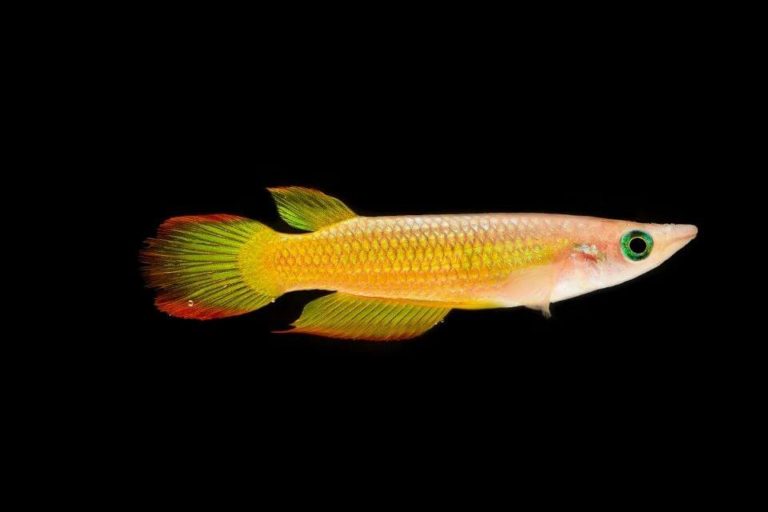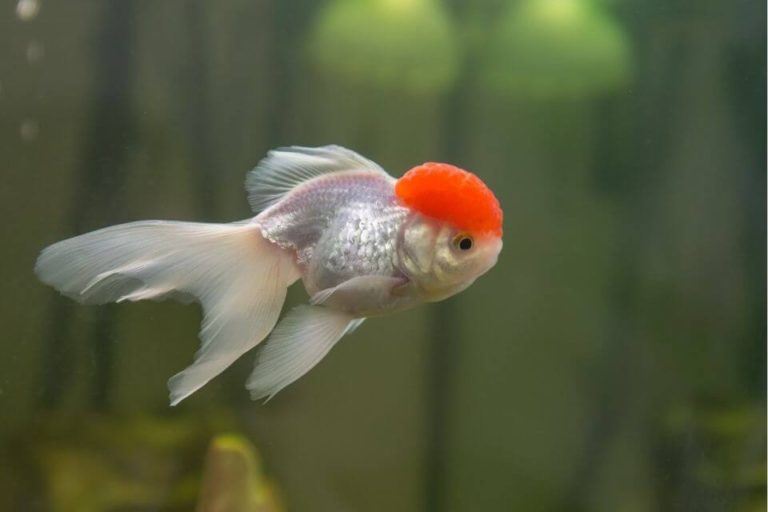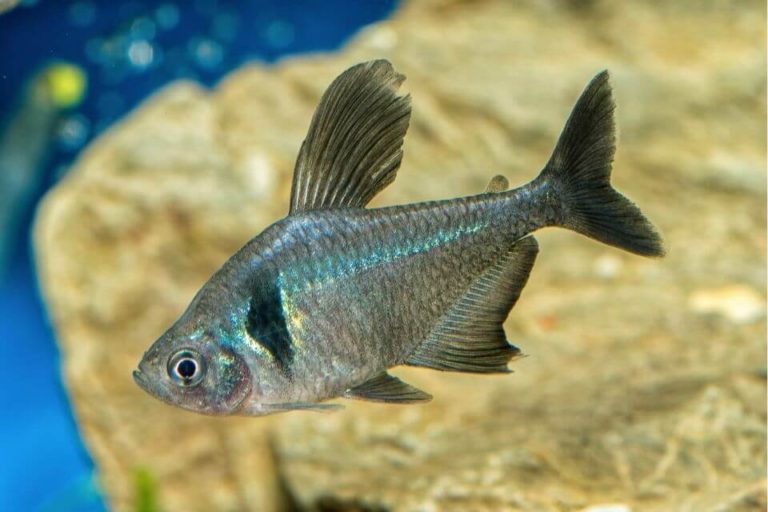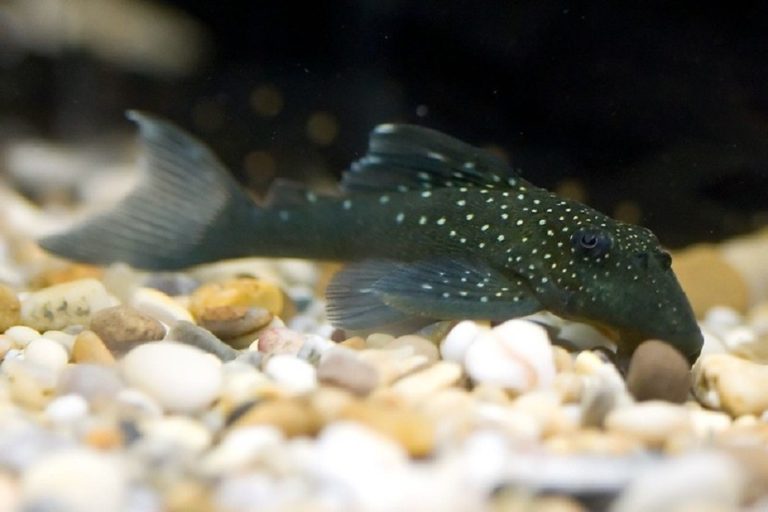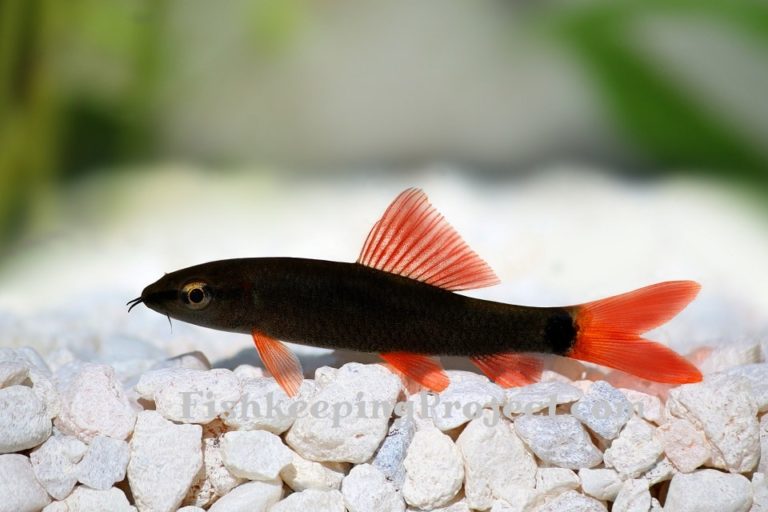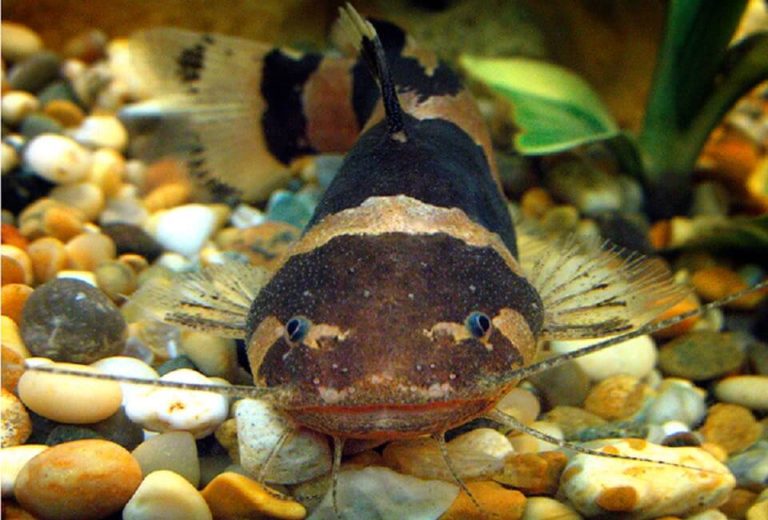Clown Killifish Care Guide: Lifespan, Size, Food, Tank Mates & Tank Size
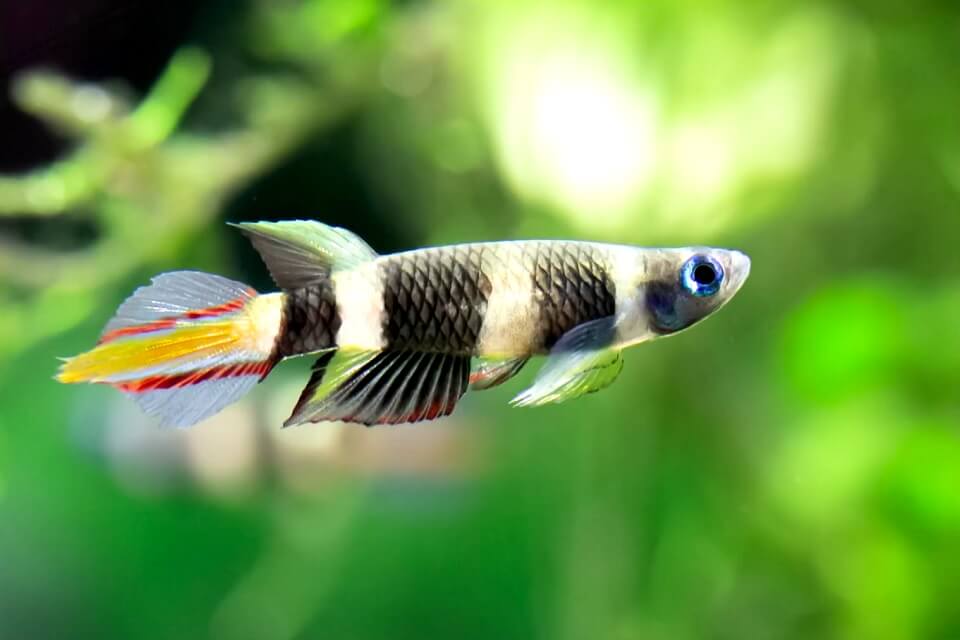
Do you want to fill your aquarium with colorful and bright appearance fish? If yes, then you can choose one of the smallest freshwater fish species known as the Clown Killifish.
Clown Killifish usually dwell on the top of your aquarium. Therefore, if you possess a large nano tank, you can go for this Killifish.
They can cover the upper part of the tank, which is often overlooked. These fish are tiny predators that wait patiently for their prey and then grab them from the water surface with upturned mouths.
Below, you will find all the things that you must know for keeping a Clown Killifish. Knowing about their origins, natural habitats, required water conditions and dietary requirements will enable you to take care of them properly.
| Quick Facts: | |
|---|---|
| Common Names | : Clown Killi, Clown Killifish, Rocket Killifish, Banded Panchax |
| Scientific Name | : Epiplatys annulatus |
| Family | : Nothobranchiidae |
| Origin | : Fresh water habitats in West Africa |
| Care Level | : Easy to moderate |
| Lifespan | : Up to 5 years |
| Size (average) | : 1.2 -1.4 inches (3 - 3.5 cm) |
| Diet | : Omnivores |
| Breeding | : Egglayer |
| Social | : Community |
| Temperament | : Nonaggressive predator |
| Minimum Tank Size | : 5 gallons |
| Temperature | : 68 - 79° F (20 - 26° C) |
| Water Hardness | : 4 - 8 dKH |
| Water pH Level | : 4 - 7 |
Overview of Clown Killifish
The scientific name is Epiplatys annulatus. Besides, there are a few other names for them Banded Panchax and Rocket Killies.
If you want a fish that can entertain you by watching the movement in your freshwater tank, then go for the Clown Killifish. These fish species do not take up a lot of space in your aquarium.
Killifish are generally found in West Africa in the regions like Sierra Leone, Southern Guinea, and Liberia. They are small and peaceful predators who feed on invertebrates and little insects that fly.
These fishes are available in plenty in areas such as swamps, marshes, water holes, and streams. You can keep them in your freshwater aquarium, but you have to know about their natural habitats to provide them with the proper care.
Since Clown Killifishes are predators by nature, you have to give them live prey. Only giving flakes and pellets will not be sufficient.
As swamp and stream water is slow-flowing, you must keep them in still water or a slow-moving tank environment. This is very important for different reasons. For instance, maintaining tank cleanliness without a filter is a bit challenging.
For this reason, you may have a water filtering system for your tank, but you must make the tank water flow as very slow as you can.
You can go without a water filter but you need to change the water regularly. Keeping foliage will allow the water to stay clean. The habitat of your aquarium also plays a crucial role.
Also when choosing tank mates you cannot have fish species who love fast water currents; therefore, they are not suitable tankmates for Clown Killifish.
You may think of having fish species who live in the same environment as tank mates.
Clown Killifish Lifespan
If you take care of your Clown Killifish properly, they live up to 5 years. In order to make them thrive, a healthy environment is also essential. As it is a long commitment, first, you have to be ready to accept that responsibility.
If you end up throwing them in a pond, they will not be able to adapt easily. This type of sudden change can cause them to die prematurely.
Clown Killifish Size
Clown Killifish grow between 1 to 1.5 inches. Juvenile Banded Panchax matures very fast and becomes sexually mature between the first 6 to 8 weeks. Within half a year, they become adults.
Clown Killifish Typical Behavior
Even if the peaceful nature of the Clown Killifish deceives us, they are predators. They do not chase the prey but eagerly wait in proximity to the surface of the water.
When the insect comes near the surface unsuspectingly, they ambush and capture them with their mouths. As they have very tiny bodies, they are under threat from other large fishes.
Therefore, you must keep them with small fish species as their size or smaller. Mostly they are shy and do well in groups of ten fish. Within these groups, they become playful and less shy.
Banded Panchaxes are little jumpers, which is why you must keep them in tanks that have a tight fit. The light of their tank needs minimal brightness. And, they prefer living in habitats that are like the marshes and streams of Africa.
Clown Killifish are very colorful, so they like to show off their appearance. So, when you have them around, you will rarely feel bored.
Clown Killifish Appearance And Colors
Clown Killifish earns the name ‘Rocket Killifish’ because of their small rocket-like appearance. They have torpedo-shaped bodies. As they get their food from the surface of the water, their mouths usually turn up to get access to the food.
Their fins are dorsal and are set downwards near the tail. The fin at the tail has lengthy rays and a spade-like shape. With their round heads, they resemble tiny pikes. They have a small size between 3 and 3.5 cm.
Clown Killifish derive their scientific names from their bright, colorful appearance, like the makeup of a clown. As they are dimorphic sexually, it is relatively easy to differentiate between females and males.
Clown Killifish mostly have a yellow, black, red, and blue color pattern. But, there are other color variations within the brood of the same kind. Similarly, the width of the stripes can also differ among individual fishes.
The males and females Banded Panchax also vary in their color.
Clown Killifish Care and Tank Setup
You can keep the Clown Killifish in a nano or micro tank as they are very small. Inside these tanks, you can keep many Banded Panchax. You can also use a big community tank that has mid and bottom inhabitants.
This is because they usually stay in the upper part of the tank. There are a few drawbacks to these tanks. They do not reproduce much if they stay in large tanks with different species.
So, if you want them to reproduce, you require a dedicated, small tank. But small tanks have filters that produce currents that are quite strong for them.
Clown Killifish Tank Size
Clown Killifish live in shallow water in their wild, natural habitat. That is why a low and long tank is more suitable for them than a deep tank. Some breeders keep them in sweater plastic boxes and reptile tanks.
A nano or a micro tank of 5 gallons will be sufficient for a Clown Killifish.
Clown Killifish Tank Setup
You can do away with filtration when setting up a tank for the Clown Killifish. Instead, you can keep floatable plants on the water surface. Some of these fishes keep their eggs on the plants.
Even adult Killifish feel secure around them. A little Java moss and peat can be a covering for the tank’s bottom. Scavengers, like small shrimps, help in disposing of unconsumed food of the Killifish.
Banded Panchax does not require very bright light. Normal aquarium lighting suits them. You can use a clay-based or sand-based substrate for your tank where you put the Killifish.
But you have to first ensure that the clay or sand does not have artificial coloring. The sand must consist of fine and small grains.
Plants help in removing nitrates from the tank’s water. This, in turn, keeps the water oxygenated. Leaf litter plays a more sustainable role in comparison to peat.
They enable microbial growth when there is some decomposition on the leaves. The humus released from the leaves also benefits the Banded Panchax.
Clown Killifish like to hide in the tank and jump on their prey. So, you can add different hiding places behind rocks and pebbles.
Also, for decoration, you can include caves and castles that are artificial. But, make sure that they do not have sharp edges or artificial colors.
Suitable Plants
Clown Killifish like having plants in their surroundings. So, you can keep plants in your aquarium or tanks. Some suitable plants that you can keep on the water surface are floaters that are Red rooted, Frogbit, and Water lettuce.
They have roots that hang in the water downwards. These plants generally give the fry protection.
Water Conditions and Parameters
Water Parameters and Conditions are essential when it comes to breeding the Clown Killifish.
In their natural, wild habitats, they are found in acidic, warm, and soft water. Therefore, water hardness between 4 to 8 dKH and a 6.0 pH with low carbonates are ideal for this fish.
Their water temperature must be between 68 to 79 degrees Fahrenheit. Any sudden fluctuations in the water will make the fish vulnerable and susceptible to health complications.
You can make any water suitable for the Banded Panchax by preconditioning it. First, you have to keep them in a particular bucket with a box filter full of peat, waterlogged.
The water can circulate for some days till it changes into a light amber color. Then, it will be perfectly suitable for the Clown Killifish. Changing fifty percent of the water every three days will keep them healthy.
You must use a buffered or gentle current if you plan to use a filter. Plants and other decorations will keep the plant still. You can even change 30% water every other week.
- Water Temperature Ranges: 68 – 70 degrees Fahrenheit (20° – 26° C)
- Acidity Levels: 4.0 to 7.0 pH
- Water Hardness: 4 – 8 dKH
Diet and Feeding
A Clown Killifish is carnivorous, and they wait to catch their prey below the surface of the water.
What Does A Clown Killifish Eat?
Thus, you can provide your Killifish larvae of mosquito, flies of fruits, and minute beetle flour-confused larvae. These fish can also consume Copepods, Nematodes, Grindal worms, and little Daphnia.
Some Banded Panchax prefers frozen food; however, they will normally take live foods and not frozen foods or pellets.
How Often Should You Feed A Clown Killifish?
You must take care of giving them foods that they eat in their natural habitats. And, feeding a Clown Killifish once or twice a day is sufficient.

Common Diseases
If you maintain the water conditions that we mentioned above, you will protect your Clown Killifish against diseases. As they are small, we must always lookout for signs of disease or illness.
Some common diseases of Clown Killifish are Columnaris, Flukes, Fish Lice, and Ich.
Columnaris
It is a bacterial infection that is generally known as cottonmouth. Mostly, we mistake it as a fungal infection. It quickly spreads, and if you do not take prompt action, it can cause the fish to die.
Columnaris, like an infection, attacks both externally and internally. In some cases, the disease turns acute. If you keep your aquarium hygienic, then it will prevent such infections.
It can be recognized by outside lesions, and you can treat them with antibacterial medicine. You must note that this infection can grow fast and kill an entire tank in a matter of a few hours.
Flukes
Flukes are parasitic infections. They are seen commonly in tropical fish. Flukes cause a great amount of mucus that can suffocate the Clown Killifish. Symptoms include the fish staying much nearer to the water surface.
If you maintain cleanliness and keep the water temperature low, you can prevent this infection. Flukes thrive in warm water.
Fish Lice
Fish Lice is like human lice, but you can spot them more easily on a fish. They are small crustaceans and have flattened shells that swim in the water with the aid of their four sets of legs.
These fish lice rapidly lay eggs, so if you notice them lurking around, you have to get rid of them completely. From a particular Killifish, you can remove lice using tweezers. Dimlin eliminates all the eggs that are laid.
Ich
Among freshwater fish, Ich is ubiquitous. Clown Killifish also have it. Parasites cause Ich. Symptoms are little white spotting over the fins and body of your fish. Some Clown Killifish also scratch and rub their bodies because they feel itchy.
It is a highly communicable infection. You must quarantine any fish that gets affected and keep them in different tanks and provide them with appropriate medication.
Lack of poor diet and loneliness can make them more prone to diseases.
Clown Killifish Gender Differences
Both the males and females have a cream-colored body. Behind their heads, there are four wide different black bands. Males have dorsal fins that are pale red, bright blue, or cream-colored. Some of this blue color also contains red.
On the other hand, females have clear dorsal fins. Male Clown Killifish have a pale or sky-blue caudal fin. In the middle, they have extended bright red rays. Some others have a light orange color in contrast to bright red.
Few are also of yellow color. Certain specimens have tips that are bright yellow. Many females have caudals that are colorless with a slight hint of yellow, faint red, and orange for their extended rays.
The males have anal fins that are blue with bright red or red outlines. Females are of a light, clear amber color. Their anal fins are clear mostly. Some also have a bright spot on the head top behind their eyes.
Clown Killifish Breeding
If you have a female and male Clown Killifish and maintain a healthy environment in your aquarium, they will breed often. Twice every month, they mate and produce about 25 fries in each cycle.
Some of the hobbyists keep spawn mops to move the eggs elsewhere to hatch. If you incorporate floating tanks into your aquarium, it will take on a more natural approach.
After the pairing of the parent Killifish, the fry hides near the plants that float on the surface. You can move them with the help of a spoon or a baster for scooping the fry up.
And shift them to a rearing tank. It is because adult Clown Killifish eats their fries.
They do not need a separate tank for breeding, but fries require a different tank to grow in. You need to do this transfer of the small fry because the other bigger fishes in the tank can feed on them.
Finally, if you want to keep them in a large tank, they will only occupy the top overlooked section of the tank.
They reproduce at a high rate. For instance, this fish can produce around 1200 fries every year. So, if you use a nano or micro tank, you will not be able to accommodate them there.
So if you plan to increase the population of Clown Killifish in your tank then think of a large aquarium in the first place.
Clown Killifish Tank Mates
You can choose peaceful and small fishes for pairing with the Clown Killifish. You can do this only when you do not plan to keep a dedicated tank for the small Killifish.
Some of the suitable tankmates of the Banded Panchaxes are:
- Corydoras Catfish
- Celestial Pearl Danio
- White Cloud Mountain Minnow
- Gouramis
- Small plecos
- Cherry Barb
- Congo Tetra
As Clown Killifish prefers to stay in the tank’s upper level, you can choose bottom and mid-level feeders.
Lastly, small snails and shrimps suit the Banded Panchax as tankmates as they help maintain the water cleanliness. Tankmates, who like the Killifish, thrive in slow-flowing, and still, water is best suitable for them.

Origin, Distribution, and Availability
In 1915, the term given to the Clown Killifish was Haplochilus annulatus by a person named Boulenger. But now it goes by its scientific name, Epiplatys annulatus.
It comes from the family of Nothobranchiidae and inhabits still or slow-motion freshwater bodies in tropical areas of West Africa.
The Clown Killifish that are nowadays up for sale in online and stores are bred in captivity. They live on the margins of water in areas with thick vegetation.
This fish species are comfortable in groups, unlike many small fishes, they do not gather together to protect themselves. Instead, they prefer staying alone and standing out among other invertebrates and fishes.
Frequently Asked Questions
There are a few common questions you may have about the Clown Killifish that we answered below.
We hope it will help you on your way. If you have more questions that we did not discuss here, do not forget to mention them in the comment section at the end of this article.
Can Clown Killifish Live Alone?
A single Clown Killifish can be kept alone in a tank of 2 gallons. But, it would be beautiful if you keep them in a group because of their colorfulness. If you decide on keeping two males together, you will need another 3 to 5 females.
It will further ensure that they do not fight with each other. To accommodate more than 2 Killifish species you have to have at least 5 gallons tank.
Are Clown Killifish Hard to Keep?
Clown Killifish is a good choice for your aquarium because of the following reasons. Firstly, they are quite small, and they can enjoy the limited space that you provide them.
Therefore, you do not need to spend your money on buying a big tank or aquarium. Their bright colors also make them sparkle in a tank of any size. Even though they are natural predators, they are peaceful with invertebrates and other fish.
Are Clown Killifish Fin Nippers?
During the spawning time, male Banded Panchax becomes very hostile towards each other. Hence, they nip each other’s fins. But, in general, they are very peaceful and pair off with other female Clown Killifish.
They are not that big to prey on the other inhabitants of the tank.
Are Clown Killifish Aggressive?
Clown Killifish can live with other Killifish. Keeping around three to eight pairs of these fish together will give a colorful and bright effect to your aquarium. But you need to provide them with enough space for swimming.
Males compete with each other during breeding which brings out their aggressive nature. That is why you must keep these fish in even numbers.
Can I Keep Clown Killifish with Betta?
Banded Panchax is compatible with Betta fish, but sometimes the latter turns aggressive. This can cause a threat to the Clown Killifish.
Do Clown Killifish Eat Other Fish?
Banded Panchax does not eat other fish species. However, they are predators and eat dwarf shrimp. Although danios, tetras form suitable tankmates for the Clown Killifish.
Can We Keep Clown Killifish with Shrimp?
Clown Killifish are tiny fishes that cannot eat shrimps. However, they eat small fries and eggs of shrimps. Therefore, you can keep adult shrimps in your community setup.
They help in maintaining a clean and tidy environment in the tank.
Final thoughts of Keeping a Clown Killifish
Among the different species of fish, Banded Panchax is quite majestic. They can breed easily and do not require any special attention. But you must provide them with live foods regularly.
If you see any swollen parts, behavior change or cut on the skin, you have to contact a vet immediately.
Clown Killifish enhance the beauty of your aquarium with their unique colors. In addition, they do not require excessive care. So, the next time you want some new additions to your tank, go ahead and choose the Clown Killifish.



